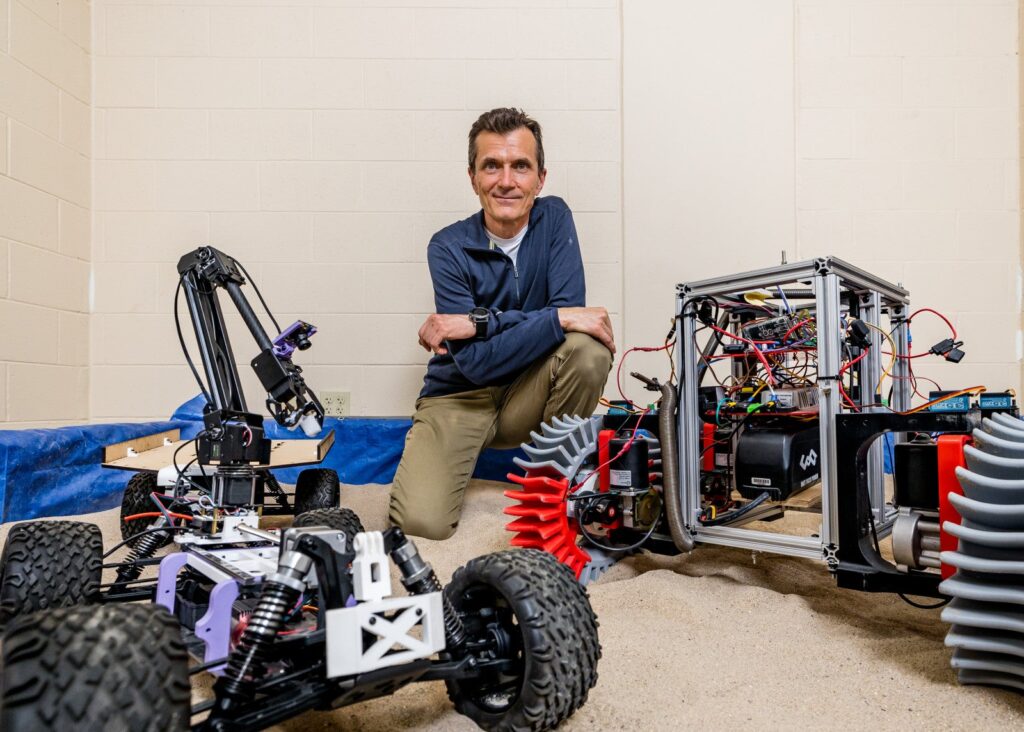
As space agencies race to set foot on the Moon, Mars, and beyond, a seemingly mundane issue could hold the key to success: the functionality of a rover’s wheels in extraterrestrial terrain. The 2009 incident when NASA’s Spirit Mars rover became mired in Martian sand served as a stark reminder that even the most advanced machines can falter in unfamiliar environments. Engineers on Earth worked tirelessly to free Spirit through remote commands, but ultimately, the rover remained immobile.
This setback prompted a reevaluation of how rovers are tested on Earth before their space missions. Researchers at the University of Wisconsin–Madison (UW–Madison) have embarked on a study that could fundamentally alter the design and testing of future rovers.
Gravity’s Hidden Influence
When deploying a rover to the Moon or Mars, engineers typically design a scaled-down test version. On the Moon, where gravity is just one-sixth that of Earth, testers simulate conditions by reducing the rover’s weight accordingly and driving it across desert sand. This method has been standard practice for decades.
However, a critical oversight exists. While the test rover may mimic its lunar weight, the sand it traverses is still subject to Earth’s stronger gravitational pull, which significantly affects testing outcomes. Dan Negrut, a professor of mechanical engineering at UW–Madison, explains that Earth’s gravity compacts the sand, giving a misleading impression of the rover’s handling capabilities. In contrast, the lunar surface is much looser, or “fluffier,” making traction more challenging to maintain. Rovers are more prone to sinking or slipping on such terrain.
“Looking back, it’s not that hard: We have to consider not only the gravity pulling on the rover but also how gravity influences the sand in order to better understand how the rover will behave on the moon,” Negrut says.
A Smarter Way to Simulate
To address this challenge, Negrut and his team developed a sophisticated solution: a computer program called Chrono. Initially created at UW–Madison and further refined through collaboration with Italian researchers, Chrono is an open-source physics simulator that allows for the simulation of rover-ground interactions under low-gravity conditions without leaving Earth.
The team applied Chrono during a NASA project to study the VIPER rover, intended for a lunar mission. Discrepancies between simulated results and actual tests at the SLOPE laboratory at NASA Glenn Research Center highlighted flaws in traditional testing. Earth-based tests showed the rover performing better than in simulations, revealing the inadequacy of conventional methods.
Chrono’s simulations consider not only the rover’s weight but also how gravity affects soil behavior. The findings were startling: previous tests that suggested a rover could easily navigate soft ground were overly optimistic.
In low-gravity environments like the Moon or Mars, soil breaks up more easily, increasing the risk of the rover becoming stuck. The study underscored the importance of accurate terramechanics—the science of vehicle-soil interaction.
The Physics Behind the Problem
The implications are significant. A rover’s grip on extraterrestrial surfaces determines its ability to perform tasks such as gathering data, sampling materials, and positioning itself to transmit information back to Earth. While reducing a rover’s weight to match lunar gravity is logical, it overlooks how soil behaves under different gravitational forces.
On Earth, higher gravity causes particles to pack tightly, hardening the soil. In contrast, low gravity results in looser particles, creating a surface more akin to powder than packed sand. Although parabolic flights offer brief glimpses of low-gravity effects, they are limited in duration. Chrono, however, provides long, repeatable simulations that capture the essence of these conditions, facilitating research into tasks like digging and bulldozing—crucial for missions focused on infrastructure or resource gathering on other planets.
Beyond the Last Frontier
Chrono’s impact extends beyond space exploration. The same simulation technology aids Earth-bound engineering challenges. The U.S. Army employs it to study tank movement over rugged terrain, while companies use it to replicate complex machinery under real-world conditions. Even watchmakers benefit from simulating millimeter gear movements.
“It’s rewarding that our research is highly relevant in helping to solve many real-world engineering challenges,” says Dan Negrut of UW–Madison. “I’m proud of what we’ve accomplished.”
Despite being open-source and free, Chrono maintains an exceptionally high standard for educational software. Negrut notes that few tech companies possess such specialized tools. “There are some types of applications relevant to NASA and planetary exploration where our simulator can solve problems that no other tool can,” he asserts.
The UW–Madison team remains committed to advancing Chrono, driven by funding from NASA, the National Science Foundation, and the U.S. Army Research Office. The software remains publicly accessible, encouraging competition and innovation. “Our concepts are in the public space, and the competition can adopt them right away, which pushes us to keep going,” Negrut says.
The researchers hope their findings prompt space agencies to reconsider rover testing methods. A rover that performs well in Earth simulations might fail on the Moon. In space exploration, advanced simulations could prove as crucial as superior hardware. With tools like Chrono, future missions may avoid costly failures and continue to push the boundaries of discovery.
Research findings are available online in the Journal of Field Robotics.
Related Stories
- NASA rover discovery suggests Mars once hosted microbial life
- Curiosity rover reveals ancient carbon cycle on Mars
- Mars Rover Discovers Traces of Ancient Martian Beaches
Like these kinds of feel-good stories? Get The Brighter Side of News’ newsletter.





